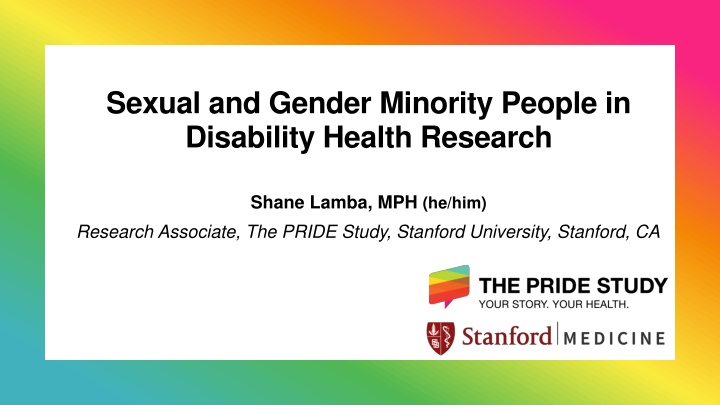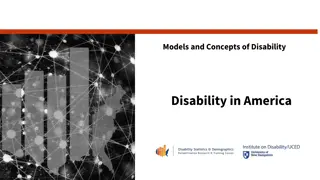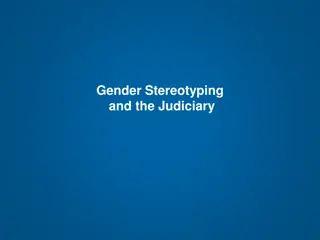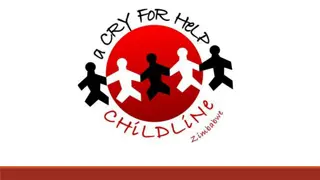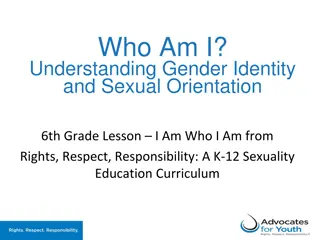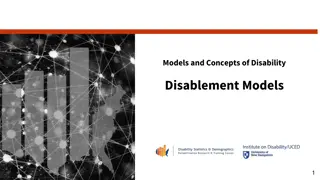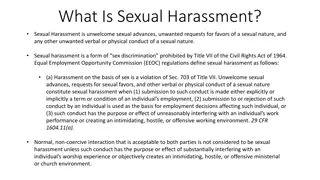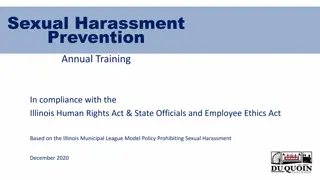Sexual and Gender Minority People in Disability Health Research
People with disabilities face barriers in accessing healthcare, compounded by challenges related to sexual and gender minority (SGM) identities. Research highlights disparities in care, including delays and lack of insurance coverage, impacting the well-being of SGM individuals with disabilities.
Download Presentation

Please find below an Image/Link to download the presentation.
The content on the website is provided AS IS for your information and personal use only. It may not be sold, licensed, or shared on other websites without obtaining consent from the author.If you encounter any issues during the download, it is possible that the publisher has removed the file from their server.
You are allowed to download the files provided on this website for personal or commercial use, subject to the condition that they are used lawfully. All files are the property of their respective owners.
The content on the website is provided AS IS for your information and personal use only. It may not be sold, licensed, or shared on other websites without obtaining consent from the author.
E N D
Presentation Transcript
Sexual and Gender Minority People in Disability Health Research Shane Lamba, MPH (he/him) Research Associate, The PRIDE Study, Stanford University, Stanford, CA
Disability Community Disparities About 26% of US population (~61 million) live with a disability1 People with disabilities are 2-3 times likely to have unmet needs & less likely to receive adequate medications2 33% of people with disabilities do NOT have access to a regular health care provider1 Barriers to care:2-4 Affordability of care Transportation issues Insurance coverage 1) CDC Disability 2) Reichard et al., 2017; 3) Mahmoudi et al., 2015; 4)) Hall et al., 2018
SGM & Disability Disparities SGM people with disabilities experience heterosexism & ableist microaggressions that affect mental health conditions such as depression5 Eliason et al. (2015) found that SGM women with disabilities face higher rates of discrimination, PTSD, anxiety SGM people with disabilities expressed poorer health due to multiple barriers of physical wellness, emotional health, functionality, and social engagement7 SGM people with disabilities are more likely to delay care because practitioners are not aware of multiple identities8 Less comfort with providers Poor knowledge 5) Conover & Israel, 2019; 6) Eliason et al., 2015; 7) Dispienza et al., 2016; 8) O Shea et al., 2021
SGM & Disability: Healthcare Barriers SGM people with disabilities were up to 1.5X more likely to have a PCP SGM people with disabilities were 1.25x more likely to be uninsured in the past 12 months Lamba S, Obedin-Maliver J, Mayo J, et al. Self-Reported Barriers to Care Among Sexual and Gender Minority People With Disabilities: Findings From The PRIDE Study, 2019-2020. Am J Public Health. 2023;113(9):1009-1018. doi:10.2105/AJPH.2023.307333
SGM & Disability: Healthcare Barriers cont. Reasons for delaying care: Affordability Insurance coverage concerns Appointment availability Lamba S, Obedin-Maliver J, Mayo J, et al. Self-Reported Barriers to Care Among Sexual and Gender Minority People With Disabilities: Findings From The PRIDE Study, 2019-2020. Am J Public Health. 2023;113(9):1009-1018. doi:10.2105/AJPH.2023.307333
Policy Implications SGM people with disabilities were 3X more likely to delay care because of disrespect or mistreatment Research shows SGM people are disproportionately experiencing discrimination ands bias when seeking healthcare services Fears about discrimination because of multiple intersecting identities Cultural competency training for health care providers & systems may be warranted to deter SGMPWD from delaying care. The need for policy changes that address the barriers of affordability, and appointment availability that prohibit proper access to care.
Conclusions + SGM people with disabilities experienced significant healthcare access barriers + ~3-8X higher rates across the four disability categories relative to SGM people with no disability + Our study confirms previous research noting that cost, insurance coverage and appointment availability were the most commonly reported barriers for SGM people too. + Future research should investigate SGM subgroup-level data to understand differences by gay, lesbian, bisexual or queer people
References CDC. Disability Impacts All of Us Infographic | CDC. Centers for Disease Control and Prevention. Published March 8, 2019. Accessed November 4, 2020. https://www.cdc.gov/ncbddd/disabilityandhealth/infographic-disability-impacts-all.html Reichard A, Stransky M, Phillips K, McClain M, Drum C. Prevalence and reasons for delaying and foregoing necessary care by the presence and type of disability among working-age adults. Disabil Health J. 2017;10(1):39-47. doi:10.1016/j.dhjo.2016.08.001 Mahmoudi E, Meade MA. Disparities in access to health care among adults with physical disabilities: Analysis of a representative national sample for a ten-year period. Disabil Health J. 2015;8(2):182-190. doi:10.1016/j.dhjo.2014.08.007 Hall JP, Shartzer A, Kurth NK, Thomas KC. Medicaid Expansion as an Employment Incentive Program for People With Disabilities. Am J Public Health. 2018;108(9):1235-1237. doi:10.2105/AJPH.2018.304536 Conover KJ, Israel T. Microaggressions and social support among sexual minorities with physical disabilities. Rehabil Psychol. 2019;64(2):167-178. doi:10.1037/rep0000250 Eliason MJ, Martinson M, Carabez RM. Disability Among Sexual Minority Women: Descriptive Data from an Invisible Population. LGBT Health. 2015;2(2):113-120. doi:10.1089/lgbt.2014.0091 Lamba S, Obedin-Maliver J, Mayo J, et al. Self-Reported Barriers to Care Among Sexual and Gender Minority People With Disabilities: Findings From The PRIDE Study, 2019-2020. Am J Public Health. 2023;113(9):1009-1018. doi:10.2105/AJPH.2023.307333 Dispenza F, Harper LS, Harrigan MA. Subjective health among LGBT persons living with disabilities: A qualitative content analysis. Rehabil Psychol. 2016;61(3):251- 259. doi:10.1037/rep0000086 O'Shea A, Latham JR, McNair R, et al. Experiences of LGBTIQA+ People with Disability in Healthcare and Community Services: Towards Embracing Multiple Identities. Int J Environ Res Public Health. 2020;17(21):8080. Published 2020 Nov 2. doi:10.3390/ijerph17218080 Kaye HS. Disability-Related Disparities in Access to Health Care Before (2008-2010) and After (2015-2017) the Affordable Care Act. Am J Public Health. 2019;109(7):1015-1021. doi:10.2105/AJPH.2019.305056 Ayhan CHB, Bilgin H, Uluman OT, Sukut O, Yilmaz S, Buzlu S. A Systematic Review of the Discrimination Against Sexual and Gender Minority in Health Care Settings. Int J Health Serv. 2020;50(1):44-61. doi:10.1177/0020731419885093 Anderson A, Dierkhising J, Rush G, Carleton M, Rosendale N, Bove R. Experiences of sexual and gender minority people living with multiple sclerosis in Northern California: An exploratory study. Mult Scler Relat Disord. 2021;55:103214. doi:10.1016/j.msard.2021.103214
Thank you! + If you re interested in learning more about The PRIDE Study, check out the website: www.pridestudy.org Contact Info: Shane Lamba, MPH Shane.lamba21@gmail.com LinkedIn: https://www.linkedin.com/in/shane-lamba/ Twitter: @ShaneLamba
